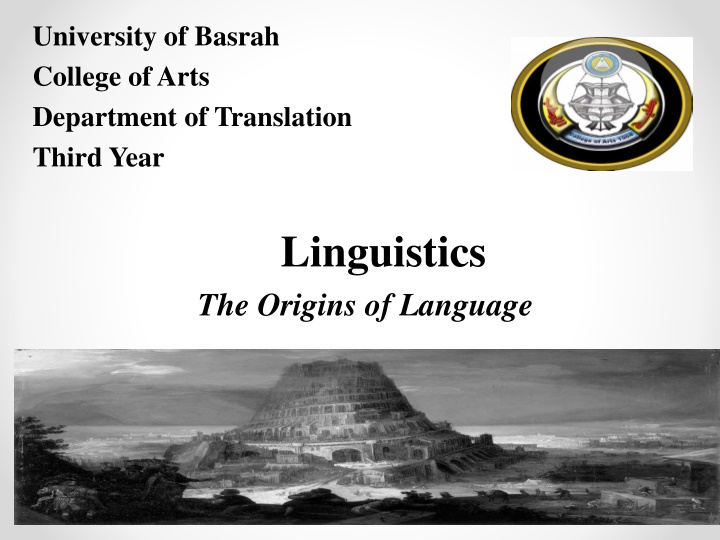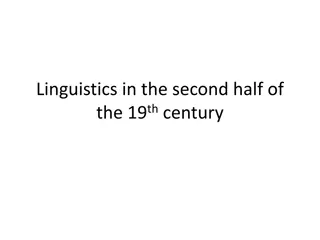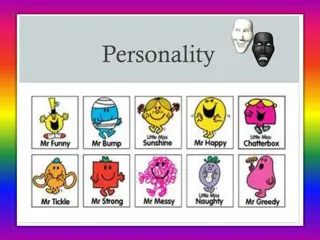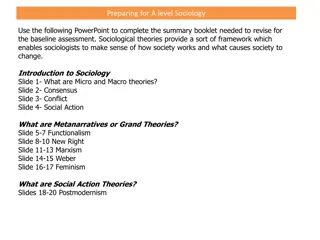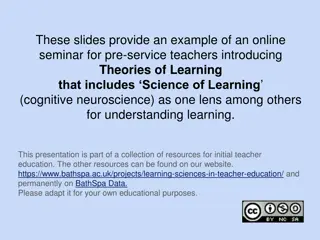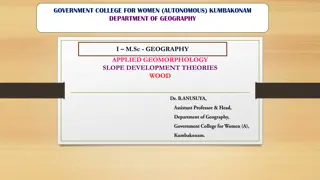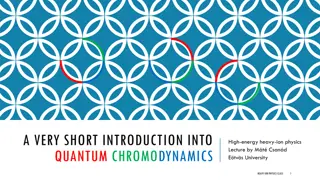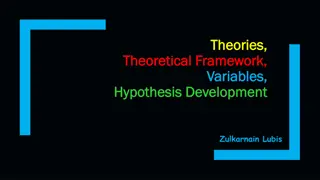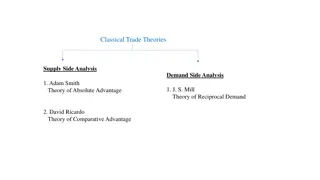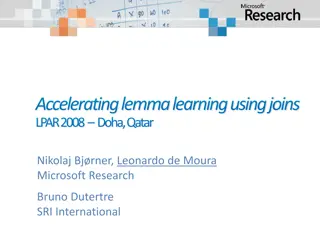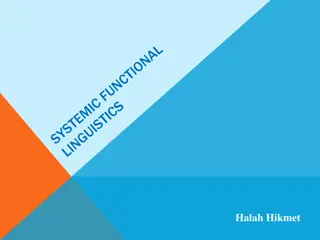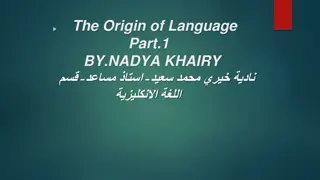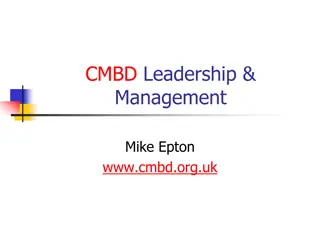The Origins of Language: Exploring Different Theories
The origins of language are debated through various theories, including divine inspiration, natural sound imitation, emotional expressions, and social interactions. From divine sources like God creating Adam to mimicking natural sounds and emotional cries, different perspectives shed light on how language may have evolved. Each theory offers unique insights into the human capacity for communication and the development of speech over time.
Download Presentation

Please find below an Image/Link to download the presentation.
The content on the website is provided AS IS for your information and personal use only. It may not be sold, licensed, or shared on other websites without obtaining consent from the author.If you encounter any issues during the download, it is possible that the publisher has removed the file from their server.
You are allowed to download the files provided on this website for personal or commercial use, subject to the condition that they are used lawfully. All files are the property of their respective owners.
The content on the website is provided AS IS for your information and personal use only. It may not be sold, licensed, or shared on other websites without obtaining consent from the author.
E N D
Presentation Transcript
University of Basrah College of Arts Department of Translation Third Year Linguistics The Origins of Language
The Divine Source In the biblical tradition, as described in the book of Genesis, God created Adam and whatsoever Adam called every living creature, that was the name thereof. Alternatively, following a Hindu tradition, it is Sarasvati, wife of Brahma, who is credited with bringing language to humanity. In most religions, there appears to be a divine source who provides humans with language. In an attempt to rediscover this original divine language, a few experiments have been carried out, with rather conflicting results. The basic hypothesis seems to have been that, if human infants were allowed to grow up without hearing any language around them, then they would spontaneously begin using the original God-given language. The Greek writer Herodotus reported the story of an Egyptian pharaoh named Psammetichus (or Psamtik) who tried the experiment with two newborn babies more than 2,500 years ago. After two years of isolation except for the company of goats and a mute shepherd, the children were reported to have spontaneously uttered, not an Egyptian word, but something that was identified as the Phrygian word bekos, meaning bread. King James the Fourth of Scotland carried out a similar experiment around the year 1500 and the children were reported to have spontaneously started speaking Hebrew, confirming the King s belief that Hebrew had indeed been the language of the Garden of Eden.
The Natural Sound Source A quite different view of the beginnings of language is based on the concept of natural sounds. The human auditory system is already functioning before birth (at around seven months). That early processing capacity develops into an ability to identify sounds in the environment, allowing humans to make a connection between a sound and the thing producing that sound. This leads to the idea that primitive words derive from imitations of the natural sounds that early men and women heard around them. Among several nicknames that he invented to talk about the origins of speech, Jespersen (1922) called this idea the bow-wow theory. The Bow-Wow Theory In this scenario, when different objects flew by, making a C AW - C AW or C O O - C O O sound, the early human tried to imitate the sounds and then used them to refer to those objects even when they weren t present. The fact that all modern languages have some words with pronunciations that seem to echo naturally occurring sounds could be used to support this theory. In English, in addition to cuckoo, we have splash, bang, boom, rattle, buzz, hiss, screech and of course bow- wow.
The Pooh-Pooh Theory Another of Jespersen s nicknames was the pooh-pooh theory, which proposed that speech developed from the instinctive sounds people make in emotional circumstances. That is, the original sounds of language may have come from natural cries of emotion such as pain, anger and joy. By this route, presumably, Ouch! came to have its painful connotations. But Ouch! and other interjections such as Ah!, Ooh!, Phew!, Wow! or Yuck! are usually produced with sudden intakes of breath, which is the opposite of ordinary talk. We normally produce spoken language as we breathe out, so we speak while we exhale, not inhale. In other words, the expressive noises people make in emotional reactions contain sounds that are not otherwise used in speech production and consequently would seem to be rather unlikely candidates as source sounds for language. The Social Interaction Source Another proposal involving natural sounds was nicknamed the yo-he-ho theory. The idea is that the sounds of a person involved in physical effort could be the source of our language, especially when that physical effort involved several people and the interaction had to be coordinated. So, a group of early humans might develop a set of hums, grunts, groans and curses that were used when they were lifting and carrying large bits of trees or lifeless hairy mammoths. The appeal of this proposal is that it places the development of human language in a social context.
The Physical Adaptation Source Instead of looking at types of sounds as the source of human speech, we can look at the types of physical features humans possess, especially those that may have supported speech production. We can start with the observation that, at an early stage, our ancestors made a major transition to an upright posture, with bi-pedal (on two feet) locomotion. This really changed how we breathe. Among four-legged creatures, the rhythm of breathing is closely linked to the rhythm of walking, resulting in a one pace one breath relationship. Among two-legged creatures, the rhythm of breathing is not tied to the rhythm of walking, allowing long articulations on outgoing breath, with short in-breaths. It has been calculated that human breathing while speaking is about 90% exhalation with only about 10% of time saved for quick in- breaths (Hurford, 2014: 83). Teeth and Lips Human teeth are upright, not slanting outwards like those of apes, and they are roughly even in height. They are also much smaller. Such characteristics are not very useful for ripping or tearing food and seem better adapted for grinding and chewing. They are also very helpful in making sounds such as f or v. Human lips have much more intricate muscle interlacing than is found in other primates and their resulting flexibility certainly helps in making sounds like p, b and m. In fact, the b and m sounds are the most widely attested in the vocalizations made by human infants during their first year, no matter which language their parents are using.
Mouth and Tongue The human mouth is relatively small compared to other primates and can be opened and closed rapidly. It is also part of an extended vocal tract that has more of an L-shape than the straight path from front to back in other mammals. In contrast to the fairly thin flat tongue of other large primates, humans have a shorter, thicker and more muscular tongue that can be used to shape a wide variety of sounds inside the oral cavity. In addition, unlike other primates, humans can close off the airway through the nose to create more air pressure in the mouth. Larynx and Pharynx The human larynx or voice box (containing the vocal folds) differs significantly in position from the larynx of other primates such as monkeys. In the course of human physical development, the assumption of an upright posture moved the head more directly above the spinal column and the larynx dropped to a lower position. This created a longer cavity called the pharynx, above the vocal folds, which acts as a resonator for increased range and clarity of the sounds produced via the larynx. Other primates have almost no pharynx. One unfortunate consequence of this development is that the lower position of the human larynx makes it much more possible for the human to choke on pieces of food. Monkeys may not be able to use their larynx to produce speech sounds, but they do not suffer from the problem of getting food stuck in their windpipe.
The Tool-Making Source In the physical adaptation view, one function (producing speech sounds) must have been superimposed on existing anatomical features (teeth, lips) previously used for other purposes (chewing, sucking). A similar development is believed to have taken place with human hands and some believe that manual gestures may have been a precursor of language. By about two million years ago, there is evidence that humans had developed preferential right-handedness and had become capable of making stone tools. Tool making, or the outcome of manipulating objects and changing them using both hands, is evidence of a brain at work. The Human Brain The human brain is not only large relative to human body size, it is also lateralized, that is, it has specialized functions in each of the two hemispheres. Those functions that control the motor movements involved in complex vocalization (speaking) and object manipulation (making or using tools) are very close to each other in the left hemisphere of the brain. That is, the area of the motor cortex that controls the muscles of the arms and hands is next to the articulatory muscles of the face, jaw and tongue. It may be that there was an evolutionary connection between the language using and tool-using abilities of humans and that both were involved in the development of the speaking brain.
The Genetic Source We can think of the human baby in its first few years as a living example of some of these physical changes taking place. At birth, the baby s brain is only a quarter of its eventual weight and the larynx is much higher in the throat, allowing babies, like chimpanzees, to breathe and drink at the same time. In a relatively short period of time, the larynx descends, the brain develops, the child assumes an upright posture and starts walking and talking. This almost automatic set of developments and the complexity of the young child s language have led some scholars to look for something more powerful than small physical adaptations over time as the source of language.
The Innateness Hypothesis As a solution to the puzzle of the origins of language, the innateness hypothesis would seem to point to something in human genetics, possibly a crucial mutation or two, as the source. In the study of human development, a number of gene mutations have been identified that relate to changes in the human diet, especially those resulting in an increase in calorie intake, possibly tied to the ability to digest starch in food and a substantial increase in glucose production. These changes are believed to have enhanced blood flow in the brain, creating the conditions for a bigger and more complex brain to develop. We are not sure when these genetic changes might have taken place or how they might relate to the physical adaptations described earlier. However, as we consider this hypothesis, we find our speculations about the origins of language moving away from fossil evidence or the physical source of basic human sounds toward analogies with how computers work (e.g. being preprogrammed or hard-wired) and concepts taken from the study of biology and genetics. The investigation of the origins of language then turns into a search for the special language gene that only humans possess. In one of the tasks at the end of this chapter, you can investigate the background to the discovery of one particular gene (FOXP2) that is thought to have a role in language production. If we are indeed the only creatures with this special capacity for language, then will it be completely impossible for any other creature to produce or understand language?
